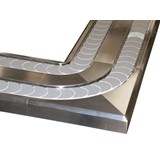Chefs, kitchen hands, wait staff; they all have specific roles and a defined subset of tasks within those roles. If you're the only one who really knows what those subsets are, that's a problem. Setting out an effective staff training program that creates the right disciplines within your restaurant can make a world of difference.
Set the goal posts
Move them later if necessary, but the first thing you need is a clear understanding of where your training program is going to end up. What is the ultimate expectation for each training task you assign?
Do your chefs need specialist training in an unfamiliar cuisine or food presentation? Do your wait staff need to operate according to a high table turnover or longer, more intimate dining experience?
Work out who you are and what you want to be before you do anything else. Not only will this clarify the most essential areas of training, it will help to define the kinds of people you should employ in the first place.
Treat your training program as a series
Your initial staff training program will be like the pilot episode of an ongoing series. Expect it to evolve. Expect it to take twists and turns as you finesse it and work out what matters and what doesn't.
Create each program like a recipe
The main ingredient will be the staff member; the meat if you'll excuse the expression. Add the fruit, vegetables and spices representing each specific training module or task required to create the finished product. Then design the recipe itself: the program encompassing the order and timing of each task as it comes together to create your ideal job-specific employee.
Define tasks clearly
It might seem obvious to you that your wait staff greet guests, but make sure they know it too. Teach them how to do it. Do they need skills to make menu recommendations and up-sell? Will they be required to answer specific questions on wines or beers? Will they have to finalise bills? Quantify every task, map it out as a full job description and train accordingly until it becomes second nature.
Seek advice
If you're not sure about the assignment of specific tasks according to job descriptions, ask someone who knows. Sites such as restaurantowner.com have generic training plans you can download as a template. Use them as a basis to help clarify details you need to include, and then set about generating a unique plan to meet your restaurant's culture and clientele.
Set a timeframe
Training takes time. Adopting a disciplined culture revolving around a thorough, holistic training program takes even longer. So don't allow any initial enthusiasm to wane over time as you get busy. Set a clear date to review each staff member and their allotted tasks. Make sure everyone knows when that date is and post it somewhere conspicuous so it remains top of mind.
Put it in writing
What happens when someone leaves and takes all their precious training with them? Take the time to prepare individual training manuals for each job type. It won't eliminate the need for more hands on training – nor should it – but new arrivals will get up to speed much faster with less time-consuming input from you.
Incentivise your program
Make it clear that your training program is there to help every staff member to do the best job they can. Also make it clear that the program will help identify talent, desire and potential much faster and facilitate quicker promotion.



